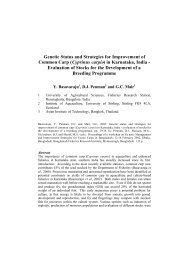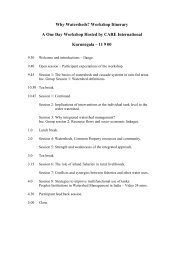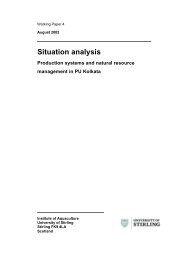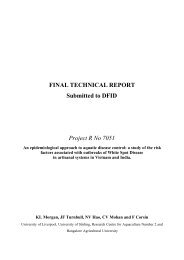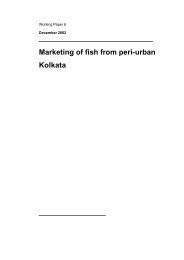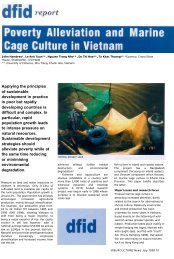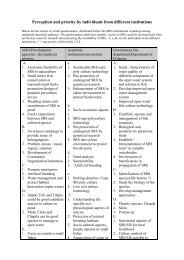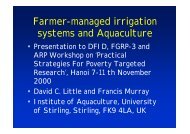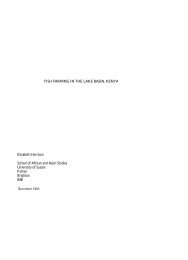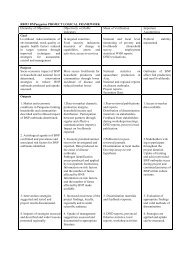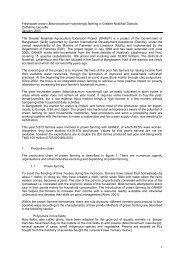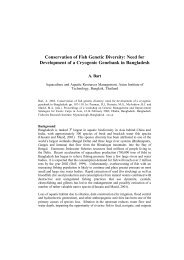<strong>Epizootic</strong> <strong>Ulcerative</strong> <strong>Syndrome</strong> (<strong>EUS</strong>) <strong>Technical</strong> <strong>Handbook</strong>No further isolates of UDRV have been obtained since 1989, but samplingstudies in Thailand have yielded an increasing number of isolates showingmorphological and electrophoretic similarities to SHRV. Two such isolateswere obtained in 1992, nine in 1994, and nine in 1996 (Kanchanakhan,1996b). A further two virus isolates were obtained in 1997, but awaitcharacterisation (Kanchanakhan, unpublished data).Aside from the rhabdoviruses, several birnaviruses and a single reovirushave also been isolated from ulcerated fish. Among the birnaviruses, sandgoby virus (SGV) from Thailand, and a more recent isolate from Singapore,have both been shown to be distinct from the IPNV reference strains (Hedricket al., 1986; Subramaniam et al., 1993). Two other birnavirus isolates wereconsidered to be more similar to known IPNV strains: these comprisedsnakehead virus (SHV) from Thailand, and another isolate that was furtheridentified as the Sp serotype of IPNV (Saitanu et al., 1986; Wattanavijarn et al.,1988). A reovirus, isolated from a diseased snakehead in 1992 (Frerichs,1995), also appears to be a new, distinct viral strain or species (Riji John,1997).The heterogeneity of viral isolations and the low recovery rate of viruses ledsome workers to the conclusion that these were adventitious agents whichwould as likely have been isolated from healthy fish (Frerichs, 1995).Kanchanakhan (1996b) has recently revived interest in viruses bydemonstrating that rhabdoviruses can be more readily isolated from fishspecimens collected during the early period of outbreaks in Thailand. Virusescould not be obtained during the middle, late and recovery phases of outbreaks.In artificial challenge studies using a rhabdovirus strain isolated in Thailandin 1994 (T9412), the virus was reisolated from 100% of snakehead fish 3 daysp.i. (post-injection), decreasing to less than 25% of fish 30 days p.i., at 20 o C,suggesting that the virus was being partially or entirely eliminated by thehost defence system (Kanchanakhan, 1996b). Successful virus isolation alsorequires that only freshly killed fish are sampled, and that tissue extracts areprepared immediately thereafter. The advised procedure for virus isolation isgiven in Annex 6.Pathogenicity of <strong>EUS</strong>-associated virusesPathogenicity trials with most <strong>EUS</strong>-associated viruses have usuallydemostrated little more than scale damage or occasional development ofminor skin lesions. Frerichs et al. (1993) were unable to show any consistentlesion in snakeheads immersed or injected i.p. (intra peritoneally) with anisolate of UDRV. Of the birnaviruses, only SHV has been tested in challengestudies. Saitanu et al. (1986) reported that i.p. injections of SHV resulted inscale damage in 80% of small snakeheads, but not at all in larger fish. RijiJohn (1997) demonstrated that the reovirus was not pathogenic to juvenilesnakeheads in injection challenges.More recent work by Kanchanakhan (1996b) showed that rhabdovirus strainT9412 can result in substantial lesions in striped snakeheads, particularlyusing challenges by i.m. (intra muscular) injection. The virulence of T9412was shown to be dependent on temperature, fish species and fish age. All22
Aetiologysnakehead fry died when challenged at 20 o C, but no mortality was recordedat 29 o C, or in other species of fish (including <strong>EUS</strong>-susceptible fish) at eithertemperature.If viruses have a role in the pathogenicity of <strong>EUS</strong>, their most likely effect isto cause skin lesions sufficient to allow entry of the fungus, A. invadans.Kanchanakhan (1996b) subjected snakehead juveniles to i.m. injections ofT9412 rhabdovirus or L15 medium, followed by bath challenges with A.invadans spores at 20 o C. <strong>EUS</strong> was induced in 100% of fish given rhabdovirusinfections and only 35% in fish given control L15 injections. This providessome evidence that T9412 may help to predispose fish to infection by A.invadans, but co-immersion challenges with the virus as well as the fungusare required to demonstrate that this can occur under more natural conditions.ParasitesSeveral metazoan (Dactylogyrus sp., Gyrodactylus sp.) and protozoan (Chilodonellasp., Trichodina sp., Costia sp., Henneguya sp., Ichthyophthirius sp.) parasiteswere identified from 273 <strong>EUS</strong> infected fish during the 1982-3 epizootic inThailand (Reungprach et al., 1983) Several fish examined before the secondoutbreak, and thought to be at an early stage of the disease, showed tiny redspots on the skin. Examination revealed a large number of Epistylis sp.protozoans (Tonguthai, 1985).In Australia, Callinan and Keep (1989) and Pearce (1990) found protozoan andmetazoan parasites present on some affected fish, but concluded that noparasite species was intimately associated with lesions and there was noevidence to suggest that parasites initiate ulcers. In their survey of affectedcountries in southeast Asia, Roberts et al. (1986) found that diseased fishcarried no more than the expected parasite load for wild rice paddy or riverinefish.It therefore appears unlikely that any parasite acts either as a pathogen ora vector for a pathogen of <strong>EUS</strong>. However, parasites may at times induce stressin fish and predispose them to infection. For example, Subasinghe (1993)demonstrated a clear association between parasite burden of Trichodina sp.on gills and susceptibility of striped snakeheads to <strong>EUS</strong> infection. It is alsopossible that external parasites may, in some circumstances, induce mildskin lesions which would allow propagules of the fungal pathogen, Aphanomycesinvadans, to attach and infect the fish host.BacteriaAvailable evidence suggests that bacteria may be important, but not essential,at two distinct stages in the pathogenesis of <strong>EUS</strong>.1. Current evidence indicates Aphanomyces invadans must attach to thedermis before it can invade underlying tissues. Cutaneous bacterialinfections (e.g. Flexibacter) may predispose fish to <strong>EUS</strong> by inducing skinlesions which provide an entry for the fungus (Figure 3).23
- Page 3 and 4: Epizootic Ulcerative Syndrome(EUS)T
- Page 5 and 6: Copies of this publication are avai
- Page 7 and 8: This handbook is one of a series of
- Page 9 and 10: ContentsIntroduction ..............
- Page 11 and 12: IntroductionEpizootic ulcerative sy
- Page 13 and 14: HistoryFor over 25 years, outbreaks
- Page 15 and 16: HistoryAlthough there were reports
- Page 17 and 18: HistoryShresta, 1994). It is estima
- Page 19 and 20: Species affectedMore than 100 fish
- Page 21 and 22: Species AffectedTable 1 Species sus
- Page 23 and 24: Socio-economicsThe most severe impa
- Page 25 and 26: Public healthPrior to the initial E
- Page 27 and 28: AetiologyDiseased fish, particularl
- Page 29 and 30: AetiologyFigure 2 SporulatingAphano
- Page 31: AetiologyInvolvement of other sapro
- Page 35 and 36: Environmental FactorsCurrent findin
- Page 37 and 38: Environmental FactorsSite character
- Page 39 and 40: DiagnosisCorrect diagnosis of EUS i
- Page 41 and 42: DiagnosisDiseased striped snakehead
- Page 43 and 44: EpidemiologyEpidemiology is the stu
- Page 45 and 46: EpidemiologyACID excessSULFATE RAIN
- Page 47 and 48: Control of EUSNow that research on
- Page 49 and 50: Control of EUSSurveillanceIt is imp
- Page 51 and 52: Epizootic Ulcerative Syndrome (EUS)
- Page 53 and 54: Epizootic Ulcerative Syndrome (EUS)
- Page 55 and 56: Annex 1 - Isolation of Aphanomycesi
- Page 57 and 58: Annex 2 - Count method for Aphanomy
- Page 59 and 60: Annex 2 - Count method for Aphanomy
- Page 61 and 62: Annex 2 - Count method for Aphanomy
- Page 63 and 64: Annex 3 - Maintenance of Aphanomyce
- Page 65 and 66: Annex 4 - Inducing sporulation inAp
- Page 67 and 68: Annex 5 - Identification of saprole
- Page 69 and 70: Annex 6 - Isolation of virusesThe i
- Page 71 and 72: Annex 7 - Investigation of EUS outb
- Page 73 and 74: Investigationof EUS outbreakspatter
- Page 75 and 76: Investigationof EUS outbreaksthat s
- Page 77 and 78: Annex 8 - EUS Sampling DatasheetsTo
- Page 79 and 80: EUS Sampling DatasheetsEUS SAMPLING
- Page 81 and 82: Annex 9 - Procedure for samplingfis
- Page 83 and 84:
AbbreviationsAAHRI - Aquatic Animal
- Page 85 and 86:
Glossaryachlyoid:acinar necrosis:ae
- Page 87 and 88:
Glossarylymphoid:melanomacrophagece
- Page 89 and 90:
ReferencesAAHRI, ACIAR, IoA and NAC
- Page 91 and 92:
ReferencesCallinan, R.B., Paclibare
- Page 93 and 94:
ReferencesFrerichs, G.N., Millar, S
- Page 95 and 96:
ReferencesLilley, J.H. and Frerichs
- Page 97 and 98:
ReferencesNoga, E.J., Wright, J.F.,
- Page 99 and 100:
ReferencesRodgers, L.J. and Burke,
- Page 101 and 102:
ReferencesViswanath, T.S., Mohan, C




